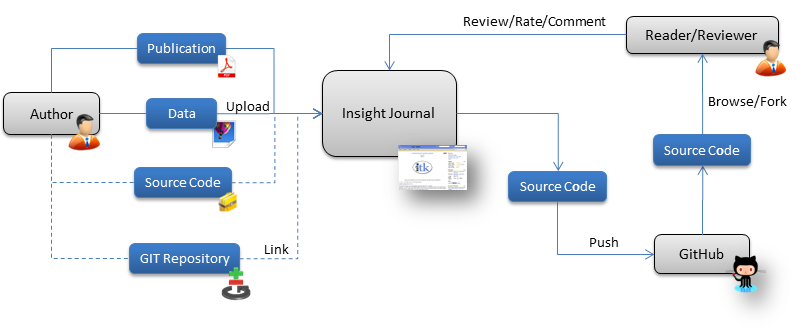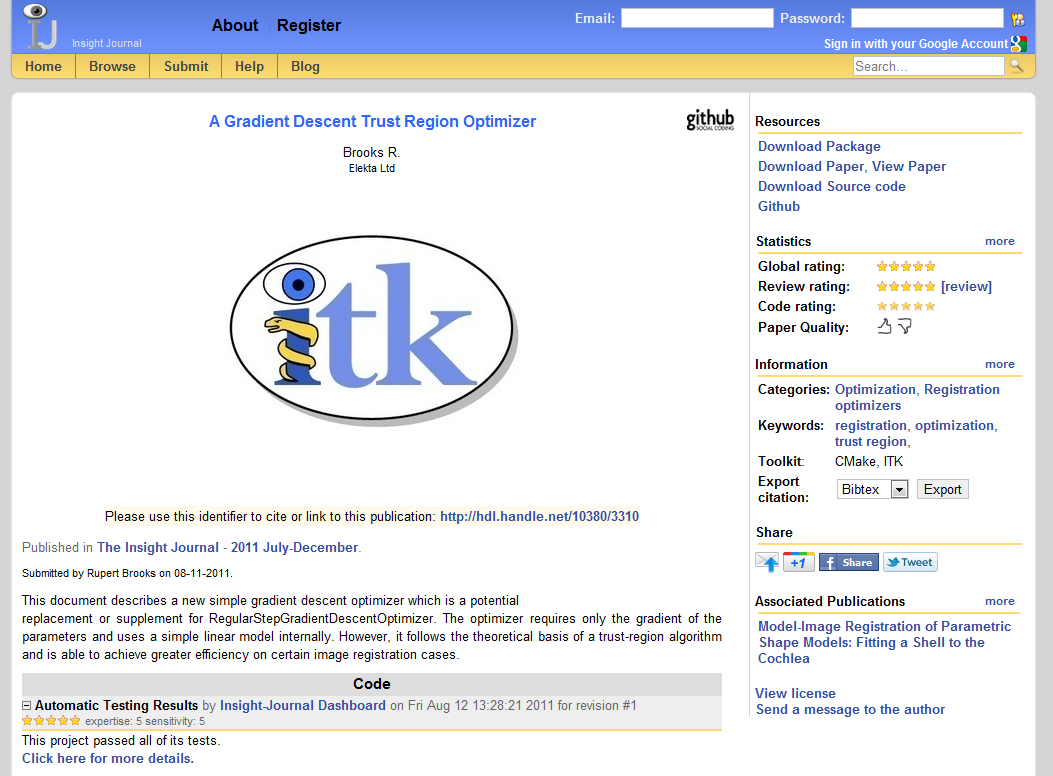The Insight Journal 3.0

Kitware’s data publishing team is pleased to announce the release of a new major version the Insight Journal. The Insight Journal is an open access journal covering scientific domains from visualization to image computing. Since its launch in 2006, the Insight Journal (IJ) has become a central resource for scientific developers around the world. Nowadays, the IJ counts more than 2300 users and hosts more than 490 publications and 840 reviews. The unique characteristics of the IJ include free and open access to not only articles and reviews but also datasets and source code. The IJ also encourages open peer-review and invites discussion between reviewers and authors in order to make the published algorithms better. The IJ supports continuous revision of articles, code, and reviews allowing developers to always find state-of-the art algorithms.
After the success of the journal for the Insight Toolkit (ITK) community, the IJ recently opened its doors to the Visualization Toolkit (VTK) community with the VTK Journal as well as a broader community of image computing methods. The IJ has also been hosting papers for workshop at the international conference on Medical Image Computing and Computer Assisted Intervention (MICCAI) since 2007.
This major release continues to focus on the dissemination of scientific open data while improving the overall user experience using new web technologies such as CSS3 or HTML5. These new features are presented below.

Figure 1: Insight Journal integration with GIT
Better code integration with GIT
GIT is a fast, open-source, distributed version control system that is quickly replacing subversion (SVN) in open source and corporate programming communities. We have integrated GIT into the Insight Journal allowing authors to directly link their publication with a public GIT repository. This allows authors to develop and improve the algorithms and link specific revisions of the code to a publication in the Insight Journal. The IJ also continues to support traditional upload (as archive files) of source code and automatically extract the source code and push it to a GitHub repository allowing readers to browse, follow and fork the code very easily. Linked GIT repositories are also mirrored on GitHub in order to keep the original copy of the code (in case the linked repository disappears in the future). Figure 1 shows how the IJ interacts with the different GIT repositories.
Quick comment and rating

In the previous version of the IJ, only full reviews were allowed, which required a detailed explanation of the review. While we kept this feature, we have also added a quick and easy way to comment on publications directly on the publication’s page. We hope that this feature will help the readers to interact more directly with the authors. We also added a quick rating system based on thumbs up/down buttons to allow the users to rate a publication without having to post a full review.
Easier login with Google OpenID
OpenID eliminates the need for multiple usernames across different websites, simplifying your online experience. We have integrated OpenID authentication with the IJ to allow authors and reviewers to login easily using their Google account. To do so, simply click on the link located on the top of the main page. The traditional registration and login process is also still valid.

Social Sharing
The web is becoming more and more social and, while the IJ had social sharing buttons available, we have improved the interface and added new networks such as Google+ and Twitter. We have also added a quick way to send pre-formatted emails regarding a specific publication to collaborators and colleagues.
Improved Search
In this new release, we have focused our attention on improving the visibility of the publications on the major search engines. We have also developed and integrated a new search engine to quickly find related publications. Thanks to this new engine based on the open-source solution Lucene, the IJ is now searchable via a powerful query language and search can now be done on the full-text (PDF) of the publication.
Example of a search query:
title:select* AND keyword:registration AND NOT keyword:”Non-rigid Registration”
Faster User Interface
In order to improve the overall user experience, we have made several changes to the user interface including:
- Faster layout using new CSS3 features
- Better display of information on the publication page
- Improved overall page loading time
- Auto-saving feature when reviewing a publication (no more lost reviews)
- New citation export tools (XML, Bibtex, etc.)

Figure 2: New Insight Journal interface
Sponsors and Acknowledgments
This work has been funded by the National Library of Medicine (NLM/NIH) under the contract HHSN276201000516U.
The Insight Journal development team would like to thank authors and reviewers who submitted feedback and bug reports.